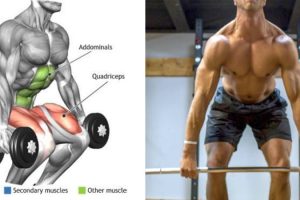You think heavy lifts equal only size and strength gains, while cardio is the ultimate approach to shedding fat? For a long time, cardiovascular training was the go-to option for anyone looking to lose weight, from bodybuilders to beauty models.
But modern science pushes us to re-think this approach by repeatedly showing us that the fat loss benefits of weightlifting greatly outweigh those of running on the treadmill. All you really need are a few tweaks in your routine to start harnessing the fat melting powers of pounding heavy iron. And this article will show you how high rep training can boost your fat loss process!
Lift Big, Lose Fat
When it comes to burning fat, one of the main differences between cardio and weight training is that high intensity strength training allows you to keep on burning fat long after finishing your workout, which is not true for cardio workouts.
This is due to weightlifting’s ability to ignite EPOC or “excess post-exercise oxygen consumption”, which indicates how long the metabolism stays elevated after exercising and in fact helps your body create the energy needed for muscle repair.
But there’s more to this tale. Namely, a 2003 study from Norway discovered that lifting heavy weights as opposed to moderate and light weights created a more intense, longer EPOC effect, while another study have found that a smartly-designed strength program can keep your metabolism elevated for up to 38 hours after the workout!
As researchers point out, muscle contraction is a primary engine of fat loss, so the more muscle mass you have to contract, the more calories you can burn, on top of stimulating a greater release of fat loss hormones.
The best of all is that resistance training will help you even gain new lean muscle while you’re cutting, as long as you’re getting enough extra protein. Which means that if you’re looking to get leaner (with the bonus of also building muscle!), big lifts coupled with a good cutting diet is the way to go.
That being said, your training routine will certainly look a lot different from the one of a powerlifter, who would stay within the lowest rep range in order to keep building his 1RM.
When getting maximally shredded is the top priority, you don’t need any “special” exercises. It’s fairly simple: keep your focus on the big three, i.e. squats, rows and presses, but perform higher reps with lighter weight, and with consistency, you’ll get the results you want.
Machines and isolation movements don’t stress as much muscle as compound movements do, so they don’t burn as many calories as a result, so you should focus your attention on the multiple compound lifts.
High rep training routines stimulate the release of HGH which is crucial to both fat loss and lean muscle growth, and bodybuilders have known about this perk at least since the 1930, when Mark Berry created his 20-rep squatting program that is still successfully practiced today.
Need to improve your conditioning and trim some fat? You can easily implement the 20-rep model into your program with the help of the tips below.
High rep training for fat loss – 20 rep program guidelines
The core of this program is to pick a moderately heavy weight and do 20 clean reps in three minutes. Doesn’t sound too complicated, right? However, it should be performed either three times a week for six weeks or twice a week for eight weeks – feel free to choose one and stick to it. Also, you will complete only one 20-rep set per exercise on two/three nonconsecutive days. If you’re a novice, it’s best to apply it on one of the three big lifts at a time.
Start with a good, thorough warm-up that will properly prepare your muscles to give 100% on the working set. Don’t attempt this without a power rack or safety pins – safety should always come first, especially when you’re dealing with a heavy barbell in the bottom of a squat.
In terms of weight selection, you can either go with your 10RM or subtract 5 pounds from your 5RM for every training session that you plan to perform and then use the total number for the load. For example, if your 5RM is 370 pounds and you’re going to train 18 total sessions, you will use 280 pounds for your 20-rep set.
For best results, use a slow and steady approach which ensures continuity – it’s better to do one rep a time with short pauses between reps instead of forcefully banging out multiple reps and then resting for longer periods. Try to maintain the same pace for the whole set. Still, keep in mind that the duration of the set shouldn’t exceed three minutes.
Oh, and expect some serious pain. Your body will be begging for you to stop, but your job is to stay focused and complete the set. If you do that, you’re guaranteed to walk out a winner!
